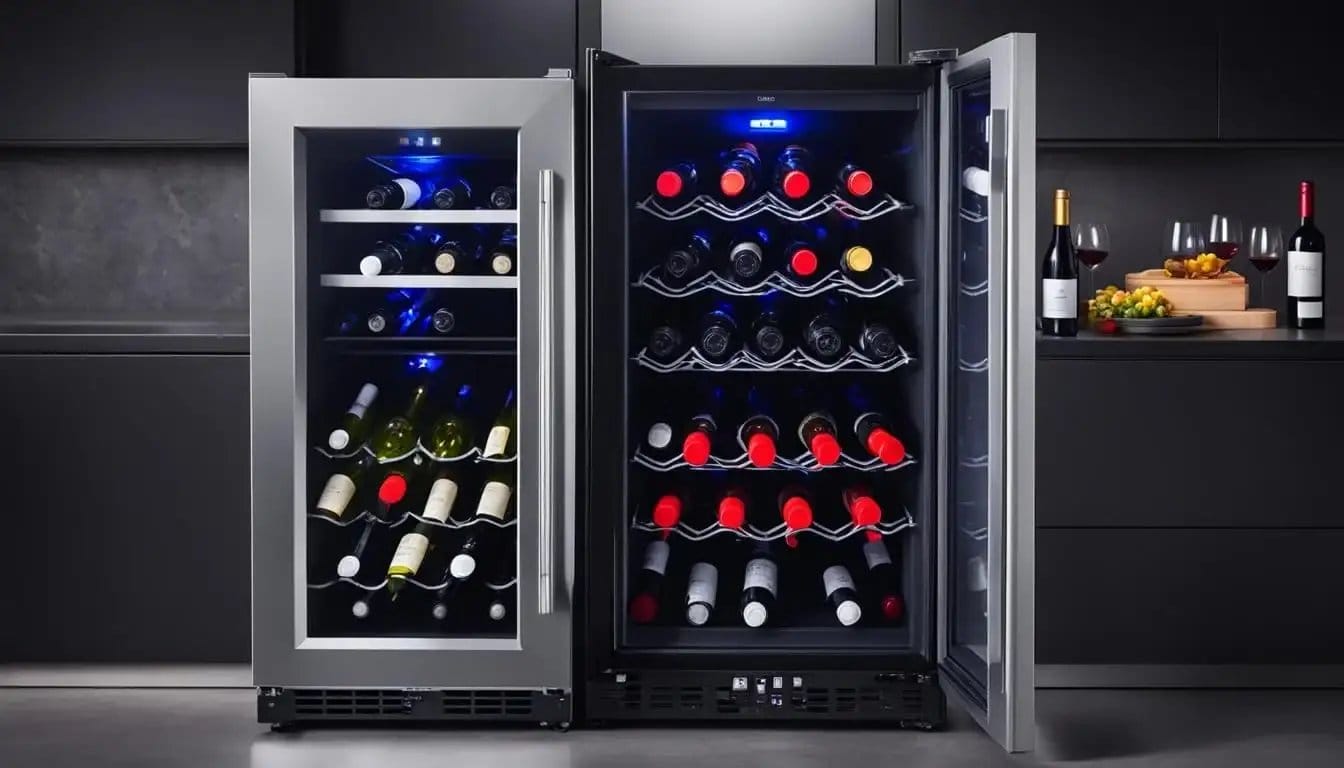When it comes to storing and serving wine, temperature plays a critical role in preserving its flavor and ensuring optimal enjoyment. Whether you’re a wine enthusiast or simply enjoy an occasional glass, knowing the ideal temperature for your wine fridge is essential to maintaining its quality and aging potential.
So, what temperature should a wine fridge be? The recommended temperature for long-term storage in a single-zone wine cooler is 60°F (15.6°C). This temperature is suitable for both red and white wines, allowing them to age gracefully and develop their unique characteristics.
However, if you’re planning to enjoy a bottle of red wine soon, it’s best served at a slightly higher temperature of around 65°F (18.3°C). On the other hand, sparkling wines and white wines are more refreshing when served between 40°F (4.4°C) and 55°F (12.8°C). This would require a dual-zone wine cooler.
Let’s get into further details!
Key Takeaways:
- Set the temperature in a dual-zone wine fridge to 60°F (15.6°C) for long-term storage.
- Red wines are best served at around 55°F (12.8°C) and 65°F (18.3°C), while white or sparkling wines are more refreshing between 45°F (7.2°C) and 55°F (12.8°C).
- Proper temperature is crucial for wine preservation and aging potential.
- Avoid drastic temperature swings to prevent spoilage and maintain wine quality.
- Choose a wine fridge with a suitable temperature range for different types of wines.
Factors Affecting Wine Storage Temperature
The proper temperature for wine storage is crucial for preserving its flavor and aging potential. Several factors can impact the quality of wine, including:
- Heat: Excessive heat can cause the wine to spoil and accelerate the aging process. It is essential to store wine in a cool environment to maintain its integrity.
- Direct Sunlight: UV rays can degrade the quality of wine and lead to undesirable aromas and flavors. It is advisable to keep wine away from direct sunlight or store it in a wine fridge with UV-resistant glass doors.
- High Humidity: Excessive humidity can lead to mold growth and damage the wine labels. Maintaining a moderate level of humidity, around 60-70%, is ideal for wine storage.
- Vibrations: Vibrations can disturb the sediments in the bottle and impact the aging process. It is recommended to store wine in a location free from significant vibrations.
To ensure optimal wine preservation, it is crucial to maintain a consistent temperature in your wine cooler or wine fridge. By controlling these factors, you can protect your investment and enjoy your wines at their best.
| Factors | Impact on Wine |
|---|---|
| Heat | Accelerates aging and spoils wine |
| Direct Sunlight | Degrades wine quality and aroma |
| High Humidity | Can lead to mold growth and label damage |
| Vibrations | Disturbs sediments and affects aging |
Recommended Wine Storage Temperature Settings
Temperature plays a crucial role in maintaining its quality and flavor. Different types of wines have specific temperature settings for optimal storage. To ensure your wines age gracefully and taste their best, it’s important to follow the recommended temperature guidelines.
1. Red Wine Storing Temperature
Red wines are typically stored at a slightly higher temperature compared to white wines. The ideal storage temperature for red wines is between 55°F (12.8°C) and 65°F (18.3°C).
2. White Wine Storing Temperature
White wines, on the other hand, require slightly lower temperature settings to preserve their delicate flavors. The recommended storage temperature for white wines is between 45°F (7.2°C) and 55°F (12.8°C).
3. Temperature Control In Wine Storing
It’s important to note that drastic temperature swings can negatively impact the quality and taste of your wines.
- Fluctuations in temperature can cause corks to expand and contract, leading to unwanted oxygen exposure and even cork popping.
- To avoid this, maintaining a consistent temperature within the recommended range is crucial.
- Having a wine fridge or cooler that allows you to set and control the temperature is essential for proper wine storage.
- These appliances are designed to maintain a consistent temperature, providing an ideal environment for your wines to age gracefully.

The Importance Of Wine Cooler Temperature Range
Maintaining the right temperature ensures that your wines age well and retain their flavors.
- A wine fridge typically offers a temperature range between 40°F and 75°F, allowing you to adjust it according to the specific needs of different wines.
- Choosing a wine cooler with the appropriate temperature range is essential to accommodate the various types of wines you may have in your collection.
- Whether you are storing red wines, white wines, or both, having control over the temperature settings ensures that each bottle is kept in the ideal conditions for preservation.
- By setting the temperature within the recommended range, you can create a stable environment for your wines, promoting proper aging and preventing spoilage.

| Wine Type | Temperature Range |
|---|---|
| Red Wine | 55°F (12.8°C) – 65°F (18.3°C) |
| White Wine | 45°F (7.2°C) – 55°F (12.8°C) |
| Sparkling Wine | 40°F (4.4°C) – 50°F (10.0°C) |
- Do note that these temperature ranges are just general guidelines, and specific wine varietals may have slightly different temperature preferences.
- It’s always a good idea to consult the recommendations provided by the wine producer or a trusted sommelier to ensure you’re storing your wines at their optimal temperature.
- With a wine fridge that offers the right temperature range and careful consideration of each wine’s specific requirements, you can create the perfect storage conditions for your collection.
- This ensures that every bottle is stored properly, allowing you to fully enjoy the flavors when the time comes to uncork them.
Types Of Wine Fridges And Their Temperature Settings
Having the right temperature is crucial for maintaining its quality and taste. That’s why there are different types of wine fridges available, each with its own temperature settings to cater to various wine storage needs.
1. Single-Zone Wine Fridge
- A single-zone wine cooler is designed to provide a consistent temperature throughout the entire unit.
- This type of wine fridge is ideal for those who prefer simplicity and don’t have a large collection of diverse wines.
- The temperature in a single-zone wine fridge is typically set at 54-55°F (12°C), which is considered suitable for both red and white wines.
2. Dual-Zone Wine Fridge
If you have a diverse wine collection consisting of both reds and whites, a dual-zone wine cooler is a great choice.
- With dual-zone functionality, you can set different temperatures for the upper and lower compartments of the fridge. This allows you to store and serve your wines at their ideal temperature.
- For red wines, the recommended temperature range is typically between 55°F (12.8°C) – 65°F (18.3°C), while white wines are best stored between 45°F (7.2°C) – 55°F (12.8°C).
Having the ability to set different temperatures for red and white wines ensures that each bottle is stored and served at its optimal condition, enhancing your wine-drinking experience.
| Type of Wine Fridge | Temperature Range |
|---|---|
| Single-Zone Wine Fridge | 55°F (12.8°C) |
| Dual-Zone Wine Fridge | Red Wine: 55°F (12.8°C) – 65°F (18.3°C) White Wine: 45°F (7.2°C) – 55°F (12.8°C) |
Proper Wine Storage And Maintenance Tips
Proper wine storage goes beyond setting the correct temperature in your wine cooler. Consider these tips to ensure optimal wine storage conditions and maintain the longevity of your wine refrigerator:
- Avoid harsh environments: Keep your wine fridge away from areas with excessive heat, direct sunlight, or high humidity. These conditions can negatively impact the flavor and quality of your wines.
- Avoid intense temperature fluctuations: Sudden and significant temperature changes can disrupt the aging process and potentially damage your wines. Keep the ambient temperature around the wine fridge relatively constant to provide a stable storage environment.
- Don’t overfill the wine fridge: While it may be tempting to fill your wine fridge to its maximum capacity, it’s important to leave enough space between bottles for proper air circulation. Overcrowding can affect temperature distribution and potentially lead to spoilage.
- Consider future wine collection growth: If you’re an avid wine enthusiast and expect your collection to grow over time, it’s advisable to choose a wine cooler with a slightly larger capacity than your current needs. This allows room for expansion without compromising storage conditions.
A well-maintained wine fridge will provide the perfect environment for your wines to age gracefully and be enjoyed at their best. Following these guidelines, you can maintain optimal wine storage conditions and ensure the longevity of your wine cooler.
Bottom Line
Overall, setting the right temperature in a wine fridge is crucial for ensuring optimal wine storage and preservation. Following the recommended temperature guidelines for different types of wines, you can enhance their flavor and aging potential.
For long-term storage, it is advised to set the temperature at 60°F (15.6°C), which is suitable for both red and white wines. It’s crucial to note that maintaining a consistent temperature is essential to prevent spoilage and avoid any negative impact on the quality of the wine.
By adhering to these guidelines and taking into account the specifics of your wine collection, you can create an optimal environment for storing and aging your wines.
Investing in a wine fridge with the appropriate temperature range and following best practices for wine storage will allow you to enjoy the best-tasting wines for years to come.
Happy cooling!
FoodiesFridge










